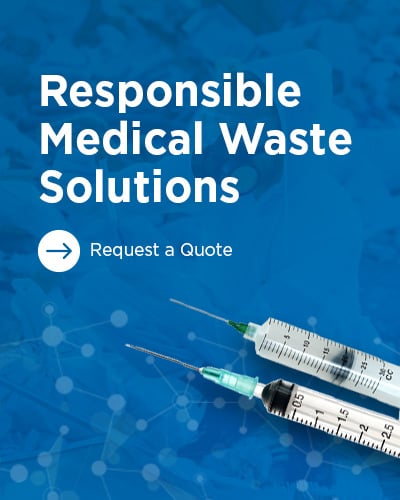Sarah Morrison
Recent Posts
For over a century and for millions of patients, dentists have been using dental amalgam to fill cavities in teeth. What is dental amalgam? The Food and Drug Administration (FDA) defines it as: “A mixture of metals, consisting of liquid (elemental) mercury and a powdered alloy composed of silver, tin, and copper. Approximately 50% of dental amalgam is elemental mercury by weight. The chemical properties of elemental mercury ...
The list of regulations surrounding dental waste and its disposal is growing rapidly. An already precise procedure, dental waste disposal undergoes constant updates in order to prevent materials from leaching into the environment. There are four main types of dental waste, and each comes with its own standard for proper disposal. In this post we will discuss the types of dental waste and their disposal methods: Amalgam ...
Medical waste, also known as healthcare waste, comes with a high risk of being contaminated by materials such as blood and bodily fluids. Due to this potentially infectious nature, there are many standards that have been put into place by the Occupational Safety and Health Administration (OSHA) when it comes to the disposal of regulated medical waste. In an effort to protect healthcare workers from unnecessary exposure to ...
Outside of healthcare facilities, approximately 9 million sharps users will administer at least 3 billion injections annually. Additionally, according to a report by the Centers for Disease Control and Prevention (CDC), as of 2015, 30.3 million Americans (9.4 percent of the U.S. population) have diabetes, and another 84.1 million have prediabetes. Every one of these sharps users will need a place to safely dispose of their ...
The handling and disposal of medical waste is a reality for any medical facility, with multiple regulations in place to ensure that the environmental impact of its disposal is as minimal as possible. With over $996 billion pharmaceuticals sold worldwide annually, it’s imperative that the disposal of the resulting medical waste is handled properly and efficiently. Both medical professionals and the public are largely unaware ...
February 4th is an annual day of recognition of the impacts of cancer, a day of empowerment for those affected by its reach, and a day of action for those who press the government to take notice. This is World Cancer Day, a moment designed to bring awareness to the 9.6 million individuals who die worldwide each year from cancer, a number greater than HIV/AIDS, malaria, and tuberculosis deaths combined. What is Cancer? ...
Flu season is currently in full swing, and its impact has already been heavily felt: the Centers for Disease Control and Prevention (CDC) reports that between October 1, 2018 and January 26, 2019 there have been 10.1 million to 11.7 million flu illnesses. Additionally, there have been 4.7 million to 5.6 million flu medical visits, and 118,000 to 141,000 flu hospitalizations. Unfortunately, these rates are all elevated, ...
It has become increasingly obvious that collecting and maintaining healthcare data of patients is imperative to ensuring that they receive the best care possible. Healthcare facilities, pharmaceutical providers, pharmacies, and doctors alike have a responsibility to provide the care that patients both demand and deserve. Collecting data through the assistance of patients is the most efficient and reliable way to gain an ...
Medical facilities have numerous methods of disposing of hazardous waste, the most common of which is incineration. Incineration is the process of burning hazardous waste at a high enough temperature that contaminants are destroyed. Any facility that chooses to incinerate their hazardous waste must utilize an EPA-approved incinerator: a furnace specifically designed to burn hazardous waste in a combustion chamber. How ...
The World Health Organization (WHO) has been pushing strongly for an increase in global awareness of antibiotic resistance. Every November, the WHO promotes World Antibiotic Awareness Week (WAAW) in an effort to enlighten the general public on best practices for the use of antibiotics. The rampant overuse and misuse of such an essential form of medication has now encouraged the spread of antibiotic resistance. Antibiotic ...
Category
- sharps disposal (30)
- Medical Waste (28)
- sharps container disposal (25)
- Compliance (20)
- sharps mail back (19)
- Pharmaceutical Waste Disposal (14)
- Infection Control (13)
- Dental Practice (12)
- Safety (12)
- biohazardous waste disposal (11)
- OSHA (9)
- Hazardous Waste (8)
- amalgam disposal (8)
- patient support programs (8)
- Universal Waste (7)
- amalgam separators (6)
- vet sharps disposal (6)
- Hazardous Waste Disposal (5)
- amalgam recycling (5)
- dental clinical waste disposal (5)
- Amalgam (4)
- ECOII Amalgam Separator (4)
- News (4)
- OSHA Training (4)
- #GLP1 (3)
- News & Regulations (3)
- medication disposal (3)
- surface disinfectant (3)
- veterinary medical waste (3)
- HIPAA (2)
- flu vaccine (2)
- influenze (2)
- BioSURF (1)
- HIPAA Compliance (1)
- HIPAA Law (1)
- HIPAA Violation (1)
- RP Returns (1)
- improving patient experience (1)
- quart containers (1)
- sharps disposal for veterinarians (1)















